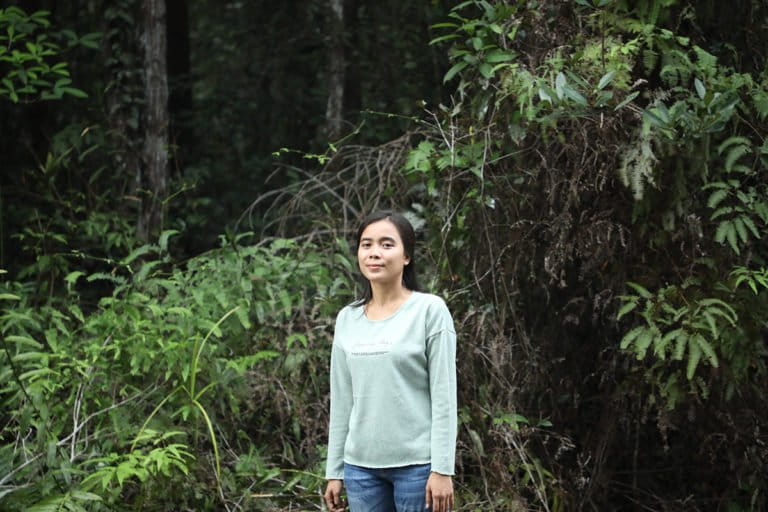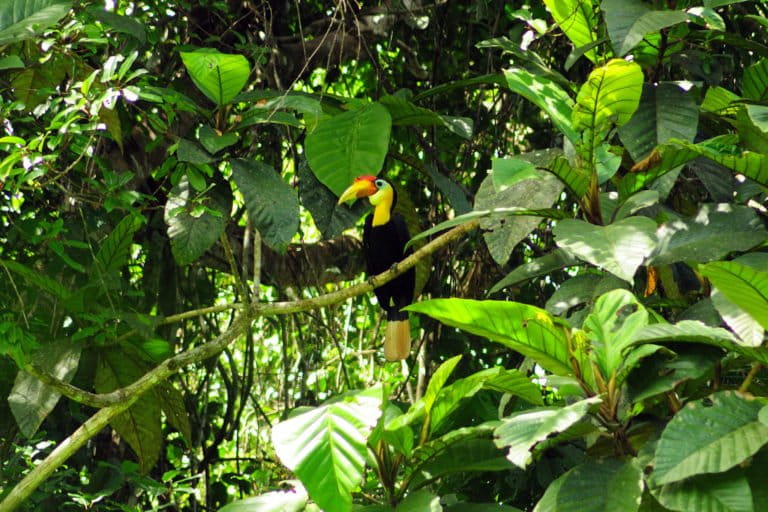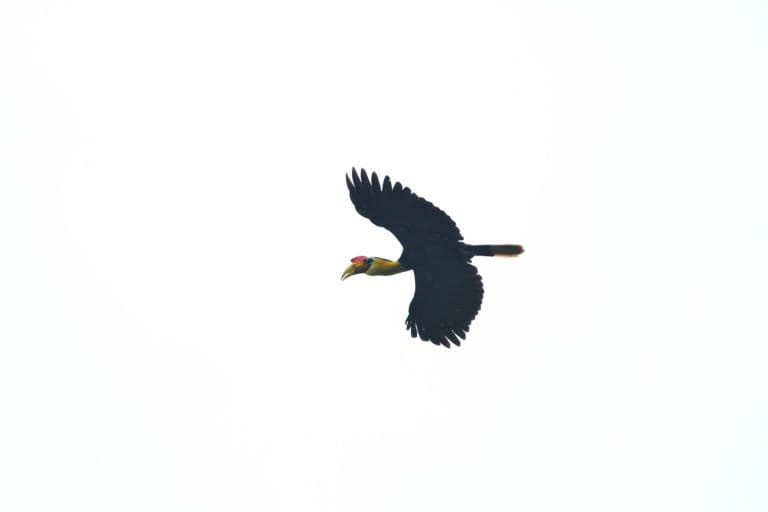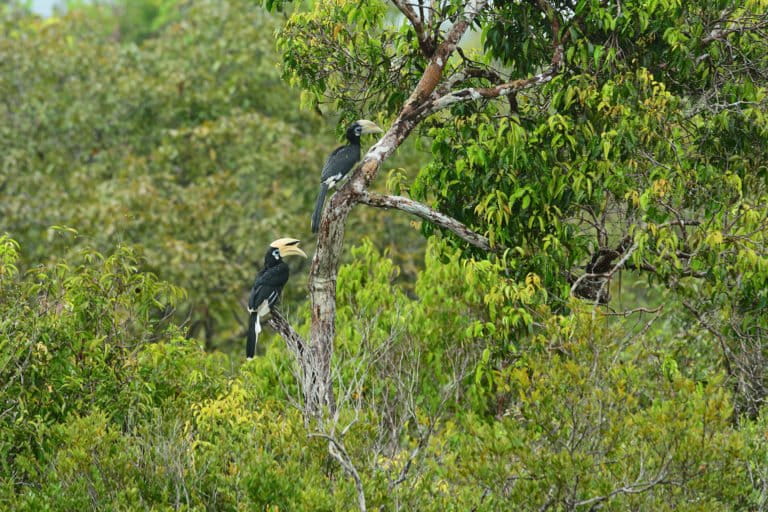- With their ostentatious bills, raucous calls, and unusual behavioral traits, hornbills are arguably one of the most charismatic groups of birds in the tropics. No country is home to more species than Indonesia, which has 13.
- Hornbills in Indonesia are particularly under threat due to habitat destruction. Some species are also targeted by the wildlife trade, including, most notably, the helmeted hornbill, whose dense casque is made up of “hornbill ivory” that’s highly sought in China.
- Until very recently, the decline in hornbill populations in Indonesia has been relatively under-appreciated. But that changed in 2013 when Yokyok “Yoki” Hadiprakarsa, founder of Rangkong Indonesia, published a report estimating that the wildlife trade killed 500 helmeted hornbills a month in West Kalimantan alone.
- In June 2019, Mongabay interviewed Yoki Hadiprakarsa and Dian Hardiyanti from Rangkong Indonesia about their work to protect hornbills in Indonesia.
With their ostentatious bills, often colorful plumage, raucous calls, and unusual behavioral traits, hornbills are arguably one of the most charismatic groups of birds in the tropics. While hornbills are found widely across tropical Africa and Asia-Pacific, no country is home to more species than Indonesia, which has 13. Within Indonesia, Sumatra leads the way with 9 species, followed by Kalimantan.
Hornbills in Indonesia are particularly under threat due to habitat destruction. Vast areas of rainforest have been cleared for plantations and agriculture, while many of the forests that remain have been impacted by logging, which often focuses on trees hornbills depend upon for food and shelter. Some species are also targeted by the wildlife trade, including most notably, the helmeted hornbill (Rhinoplax vigil), whose dense casque (a showy protrusion atop the animal’s bill) is made up of “hornbill ivory” that’s highly sought in China.

The loss of hornbills is having real and significant impacts on Asian forests, since hornbills are critically important seed dispersers. When they are extirpated from a forest, that ecosystem’s ecological function is degraded.
Until very recently, the decline in hornbill populations in Indonesia was relatively under-appreciated. But that changed in 2013 when Yokyok “Yoki” Hadiprakarsa, founder of the Indonesian Hornbill Conservation Society, better known in Indonesian as Rangkong Indonesia, published a report estimating that the wildlife trade killed 500 helmeted hornbills a month in West Kalimantan alone. That finding shocked NGOs and the Indonesian government into action.
Today, Rankong Indonesia is recognized as one of the leading organizations working on hornbill conservation in Indonesia. In a recent visit to Kapuas Hulu, West Kalimantan, Mongabay had an opportunity to travel with Dian Hardiyanti of Rangkong Indonesia to one of the group’s projects with the Dayak Iban community of Sungai Utik. After the visit, Mongabay also spoke with Rangkong Indonesia founder Yoki Hadiprakarsa. Below is an interview with the two hornbill conservationists.


AN INTERVIEW WITH DIAN HARDIYANTI and YOKYOK HADIPRAKARSA
Mongabay: What is your background and how did you come to work with hornbills?
Dian: My educational background is Bachelor of Science at Pakuan University, Bogor. My passion for conservation led me to do research on the illegal turtle trade for my final thesis. After finishing my studies, I met Yoki and he invited me to join a very ambitious hornbill research project: a hornbills’ population assessment in a district located in Kapuas Hulu, West Kalimantan Province, Indonesia. I thought it would be a valuable opportunity to improve my understanding and expand my knowledge as a researcher and conservationist.


Yoki: I have a passion for nature, that is why I took a wildlife biologist as my life path. In 1999, I received a research scholarship from Wildlife Conservation Society – Indonesia Program (WCS-IP) to spent a whole year to finishing my undergraduate research on hornbills in Way Canguk Research Station in Bukit Barisan Selatan National Park, Sumatra. In the same year, I also initiated long-term hornbill monitoring there, which led me to be hired by WCS-IP as a junior wildlife biologist. After graduating in 2000 I had a great opportunity to present my first hornbill research in the 3rd International Hornbill Conference (IHC) in Thailand. This became a milestone because the experience exposed and introduced me the international hornbill community.
In the early years of my professional career, I spent most of the time in the research station monitoring hornbill population and breeding. In 2004 I had a special opportunity to conduct province-wide hornbill survey in Southern Sumatra. Later, this research was used for my graduate work at the Warnell School of Forestry and Natural Resources at the University of Georgia in the United States.
For the 4th International Hornbill Conference in South Africa, I was appointed as co-chairman for the Asian Hornbill Network. As for now, I’m a member of the Steering Committee of the IUCN-SSC Hornbill Specialist Group and Research Coordinator for Helmeted Hornbill Working Group. At the national level, I was recently appointed as Chairman of the National Partnership for Indonesia Hornbill Conservation.


Mongabay: What do you do? What does a day look like?
Dian: I’m a research officer at Rangkong Indonesia. I focus on hornbill research in Kapuas Hulu District. Every month, we visit villages and forests to do interviews with local people. We ask villagers about their perspective on hornbills, like do they have local wisdom about hornbills, have they ever hunted a hornbill in the past, do they have customary laws to protect hornbills, do they use hornbill body parts for traditional ceremonies, and how they get hornbills from the wild. In general, the Dayak tribe has a strong relationship with hornbills, because hornbills were being used for customary needs and figures prominently in their mythology as a symbol of courage.
On each visit we also spend 10 days in the forest to conduct a hornbill population survey, which cover eight hornbill species. We mark where we find hornbills and hornbill nests. We analyze whether the quality of habitat for hornbills, including the prevalence of trees important for their diets.
In general, hornbills are very important for traditional Dayak culture.


Yoki: During my undergraduate research, I found hornbill conservation in Indonesia is lacking in many aspects, despite the fact that we have the richest hornbill assemblage with 13 species and the largest habitat for hornbills in Asia. For example, in a literature search I found only 40 scientific publications over four decades related to Indonesian hornbills. Most of this research was conducted by foreigners and there were no integrative conservation actions for Indonesian hornbills. It was a bitter finding that encouraged me to persistently work with the hornbills.
Since then, I have taken every opportunity to work with hornbills, whether I had support or not. In 2009 I launched the Indonesian Hornbill Information Center website (Rumah Informasi Rangkong Indonesia – RIRI, in Bahasa). The idea was simple: provide any information on hornbills, both popular and scientific. I was also collecting information on hornbill sightings and scientific publications on hornbills. For this, I didn’t get any support, since it is difficult to get financial support for non-celebrity species like hornbills. Later, I also started using all mainstream social media along with the website.
After returned from the U.S., I spent most of my professional career working with numerous development agencies on projects related to biodiversity and conservation. I also worked independently on sustainability-related issues on various concessions from mining to palm oil. During this period, I witnessed the beginning of the helmeted hornbill crisis and, with the generous support from Chester Zoo Conservation Fund, decided to conduct the first investigation on the issue. Those findings about the extent of the crisis shocked the world.
Since then, I decided to establish Indonesia Hornbill Conservation Society/Rangkong Indonesia as part of a research unit in the Rekam Nusantara Foundation, which we established with Ridzki and four other colleagues. Afterward, I tried to advocate at the national and global level to persuade people to take action on the Helmeted hornbill crisis. Luckily this worked and policies have been put into place at both the international and national levels. These changes have impacted both directly and indirectly sources of threat: hunting and illegal trade.
How? Well, today most famous big international conservation NGOs have prioritized the helmeted hornbill. The Indonesian government has launched a national conservation action plan for the next 10 years (2018 – 2028). This action plan is paramount for the government to allocate more budget and direct its partners to implement the plan. For assurance, the government established a National Partnership for Indonesian Hornbill Conservation, not just for helmeted hornbill.
From a global perspective, the Global Conservation Action Plan is also in place and range state countries, as well as NGOs, have also prioritized hornbill conservation.
I’m quite happy with these outcomes, which builds momentum on top of our earlier work. With Rangkong Indonesia and Rekam Nusantara Foundation, we are going always work on the frontline for Indonesia hornbill conservation.


Mongabay: Can you give more more specifics on your initiatives?
Yoki: The helmeted hornbill (Rhinoplax vigil) is the most hunted hornbills for its unique solid casque. In 2013, we found at least 6,000 birds were being killed by opportunistic or organized poacher groups across West Kalimantan alone. Many of the hunters live in the area where the Helmeted hornbill occurs and killed the birds for their daily survival. This is a bitter fact that we are facing.
However, there are many success stories of beneficial relationships between people and birds through birdwatching tourism that gives people income while ensuring that the birds thrive. We strongly believe these communities have a great potential to be a conservation frontline for guarding hornbills. This idea is possible if there is an economic relationship between birds and communities without killing the birds.
Three years ago, we initiated a hornbill guardian project in collaboration with Nature Conservation Foundation, India funded by the Whitley-Segré Conservation Fund. This project has laid the foundation for a hornbill guardian program with the Sungai Utik people and beyond. Such initiative will be the first in Indonesia.

Mongabay: What have been some of the key findings of your work?
Dian: We found helmeted hornbills are getting harder to find, even in the remote forest areas, which might be a full two days travel by boat. It’s surely the result of hunting and habitat loss. The best potential habitat for hornbills is still primary forest, but we find the best hornbill population in hutan desa (community forest). My hypothesis is that traditional people protect the forest. For example, when they go out hunting, they are also monitoring the forest.
In the cultural context, hornbill is used in many traditional rituals, such as welcome dances for guests among the Iban and Punan tribes as well as wedding and birth ceremonies in Dayak Pangin and Dayak Punan.
Dayak Punan and Iban communities have customary laws built around a mythology that hornbills are their heroes or gods. For example, there is a belief that if you hear a rhinoceros hornbill calling during tribal conflict, you follow the call because it will lead you to a safe place.
Dayak culture is very closely tied to hornbills. Therefore if they let go hornbills go extinct, they will lose their culture.
Yoki: At a species level, my studies found that hunting is seriously impacting the helmeted hornbill population in the wild. In some areas, helmeted hornbills have been extirpated due to the deadly combination of hunting and habitat loss, e.g Kutai National Park. Sadly, our ongoing project found that hunting is still occurring, despite a drastic fall in the population and increased law enforcement. Why is this still happening? The demand still out there! Including some indication of demand for live birds!
At a local level, I’ve found that communities have great potential to benefit from the presence of hornbills via bird ecotourism.

Mongabay: In general, is the public very much aware of the status of hornbills?
Dian: The general public isn’t that familiar with hornbills. Due to educational materials we have in school, they are more likely to know species from other countries than native fauna. People are often surprised to learn that hornbills are endangered.
Even in public spaces, the authorities often make mistakes or misunderstand between hornbill species. Our role is to educate them about hornbills and their status in the wild. We are doing campaigns and awareness-raising in several villages and visiting schools.
Yoki: At the global level, knowledge on Indonesian hornbills is still surprisingly lacking. Even mainstream media still confuse hornbills with toucans and make other mistakes like using the wrong name for species, let alone understanding their protection status. However thanks to social media, public awareness on hornbills is growing.
The global wildlife conservation paradigm must be changed to to support non-celebrity or less-known species which face serious threats.
Indonesian hornbills are one of our greatest biodiversity treasures. Their ecological function of nurturing our vast tropical rainforest is irreplaceable. Indonesians should be proud that we have them in our lives, now and in the future to come.

Mongabay: Do you have advice for anyone wanting to pursue a career in conservation in Indonesia?
Dian: Very few people in Indonesia work in conservation. People often think it’s hard, low paid, and requires going to remote areas that are seemingly dangerous. But, if are passionate and work hard, you will cope with all the challenges and find opportunities. If you’re going into conservation research as a career, you need to be serious, patient, and curious. If you’re a life-long learner, a career in conservation can be very rewarding.
Banner image: A fresh helmeted hornbill head. Photo by Rangkong Indonesia / Yoki Hadiprakarsa
